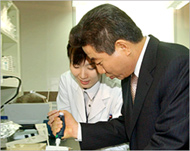T-rays: Next step in science evolution
They can see through clothing, plastic and packaging well enough to identify explosives, guns or even biological weapons instantly and accurately.

They have the potential to become a powerful new weapon in the fight against crime and can also penetrate bad weather, dust or smoke better than infrared or visible systems.
They can even detect diseases such as cancer.
Welcome to the cutting edge of radio and optical science, TeraHertz Rays, or T-rays, discovered a century ago, but developed into a useable technology only within the last few years and about to be showcased by an international conference in Australia this week.
Leading scientists from Australia, the United States, Europe and Asia will share the latest advances in the technology at the conference, sponsored by the Australian government’s Defence Science and Technology Organisation (DSTO) at Adelaide University on Thursday and Friday.
One of the principal speakers will be the acknowledged “father” of T-rays, professor Xi-Cheng Zhang of New York‘s Rensselaer Polytechnic Institute, who has spent more than 20 years developing them.
Difficult area
Recognised as a difficult area of physics, T-rays are described as emissions between infrared and microwaves.
 |
|
Medical diagnosis stands to |
“Most molecules vibrate in the terahertz frequency, so if you can detect them with T-rays, you can get a very good ‘fingerprint’,” conference organiser, Adelaide University professor Derek Abbott said in a statement on Tuesday.
“T-rays pass through things like food packaging, clothing, plastic and cardboard enabling us to analyse what is inside.
“This means they can be used to detect and identify weapons of metal or plastic, illicit drugs or biological hazards like anthrax, even if they were hermetically sealed.
Low energy
Abbott continued: “You can find out much more about the substance than you would with optical, infrared or x-ray imaging, and this helps to identify it precisely.”
|
“One of the most important recent discoveries is that Derek Abbott, |
Because T-rays are low energy, they are also safe to use around people, unlike X-rays.
He added: “One of the most important recent discoveries is that T-rays can also be used to detect cancer. Australia is part of the big scientific race to find out why.”
Scientists believe that due to their low penetrating power of the human body, T-rays would probably be used to scan the outer skin or, on endoscopes, to scan the bowel and other organs for early signs of cancer.
Abbott said the potential applications of T-rays are huge, from food safety and quality monitoring, to disease detection, airport security, postal scans for drugs, explosives or bio-weapons, military threat detection and medical diagnosis.